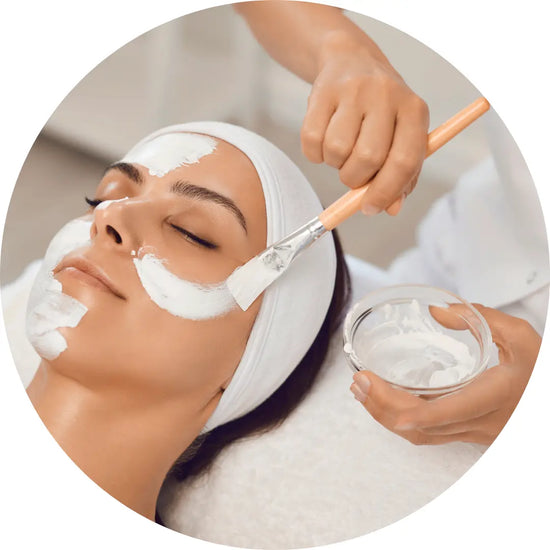What Is A Dermaplane Balm And How Does It Work?
A dermaplane balm is a specially formulated skincare product designed to be used during the process of dermaplaning.. Here's how a dermaplane balm works:
Provides a Smooth Surface
Glide and Lubrication: Our dermaplane balms are typically rich, emollient products that provide a smooth, lubricated surface for the skin to absorb other products.
Even Application: Applying a dermaplane balm helps in achieving a consistent exfoliation and removal of hair across different areas of the face.
Hydrates and Nourishes the Skin
Moisturising Ingredients: Our dermaplane balms contain hydrating ingredients. These ingredients help keep the skin hydrated during the dermaplaning process, which is crucial for maintaining the skin’s natural moisture barrier.
Prevents Dryness: The balm helps prevent the skin from drying out during the exfoliation process, leaving the skin feeling soft and supple afterward.
Soothes and Protects the Skin
Calming Ingredients: Dermaplane balms often include soothing ingredients. These ingredients help calm the skin and reduce the risk of irritation or redness that can sometimes occur with exfoliation.
Barrier Support: The balm acts as a protective layer that shields the skin from potential irritation, ensuring that the dermaplaning process is gentle and non-irritating.
Enhances the Effectiveness of Dermaplaning
Improved Exfoliation: By providing a smooth surface and hydration, the balm allows the dead skin cells and vellus hair to be removed efficiently. This can enhance the overall results of dermaplaning, leading to smoother, brighter skin.
Promotes Product Absorption: Removing the top layer of dead skin cells with the aid of a dermaplane balm can improve the absorption of subsequent skincare products. After dermaplaning, the skin is more receptive to our serums, moisturisers, and treatments, allowing them to penetrate deeper and work more effectively.
Easy Application and Removal
User-Friendly: Our dermaplane balms are typically easy to apply and remove. They are spread evenly over the face before starting the dermaplaning process, ensuring that the entire surface is prepped and ready. After dermaplaning, any remaining balm can be gently wiped away or massaged into the skin.
No Residue: A good dermaplane balm should not leave any heavy or greasy residue, making it suitable for use as part of a regular skincare routine.
Can Dermaplane Balms Be Used On All Skin Types?
Yes, a dermaplane balm can generally be used on all skin types, but it’s important to choose a balm that is formulated to address specific skin concerns and sensitivities. Here’s how our dermaplane balms works for different skin types and what considerations to keep in mind:
Normal Skin
Benefits: People with normal skin can use any of our dermaplane balms without significant concerns. These balms will help provide a smooth glide for the dermaplaning tool, protect the skin, and offer hydration and nourishment.
Choosing a Balm: Choose a balm that offers balanced hydration and contains soothing ingredients to maintain the skin’s health and enhance the results of dermaplaning.
Dry Skin
Benefits: Our dermaplane balms are especially beneficial for dry skin, as they provide an extra layer of moisture and protection. The balms help prevent the skin from becoming overly dry during the exfoliation process and keeps the skin barrier intact.
Choosing a Balm: Opt for a balm rich in hydrating and emollient. These ingredients will help keep the skin moisturised and prevent it from feeling tight or flaky after dermaplaning.
Oily and Combination Skin
Benefits: While oily skin may naturally produce more sebum, dermaplane balms can still be beneficial. The balm can help balance oil production.
Choosing a Balm: For oily or combination skin, select a lightweight balm that won’t clog pores or leave a heavy residue and which provides hydration without contributing to oiliness.
Sensitive Skin
Benefits: Our dermaplane balms can be very helpful for sensitive skin, as they provide a protective barrier and help reduce friction during dermaplaning, minimising the risk of irritation or redness.
Choosing a Balm: Choose a balm with soothing ingredients. Avoid balms with artificial fragrances, alcohol, or harsh chemicals that could potentially irritate sensitive skin. Always do a patch test before using a new product to ensure it won’t cause a reaction.
Acne-Prone Skin
Benefits: Our dermaplane balms can be beneficial for acne-prone skin by helping to remove dead skin cells and prevent clogged pores. Our dermaplane balms can help reduce the risk of irritation or breakouts.
Choosing a Balm: Look for a balm that is non-comedogenic and contains ingredients with antibacterial or anti-inflammatory properties, such as tea tree oil or salicylic acid, which can help manage acne. It’s essential to use the balm carefully and avoid active breakouts to prevent spreading bacteria and worsening acne.
Mature Skin
Benefits: Mature skin can benefit from the use of dermaplane balms as they provide hydration, reduce the appearance of fine lines, and help improve skin texture. Dermaplaning can enhance the absorption of anti-aging products.
Choosing a Balm: Select a balm rich in antioxidants and hydrating ingredients, which can provide additional anti-aging benefits and help protect the skin from environmental stressors.
How Should I Use A Dermaplane Balm?
Using our dermaplane balm correctly is crucial for achieving the best results from your dermaplaning session. Here’s a step-by-step guide on how to use a dermaplane balm effectively:
Prepare Your Skin
Cleanse Your Face: Start by thoroughly cleansing your face to remove any makeup, dirt, and oil. Use our gentle cleansers one that suits your skin type to ensure your skin is clean and ready for dermaplaning.
Pat Dry: Gently pat your face dry with a clean towel. Your skin should be completely dry before applying the dermaplane balm.
Apply the Dermaplane Balm
Take a Small Amount: Scoop out a small amount of the dermaplane balm using clean fingers or a spatula. A pea-sized amount is usually sufficient, but you can adjust based on the size of the area you're treating.
Warm It Up: Warm it up between your fingers to soften it. This will make it easier to spread evenly across your skin.
Apply Evenly: Gently massage the balm into your skin, focusing on the areas you plan to dermaplane. Apply an even, thin layer, ensuring that all the areas you’ll be working on are covered. The balm provides a smooth surface for the dermaplaning tool to glide over.
Remove Excess Balm
Wipe Off Residue: After you’ve finished dermaplaning, use a soft, clean cloth or our cotton pads to gently wipe away any excess balm and the removed hair and dead skin cells.
Rinse Your Face: If needed, rinse your face with lukewarm water to remove any remaining balm residue. Pat your skin dry with a clean towel.
Follow Up with Skincare
Apply a Toner: Use a gentle, hydrating toner to soothe the skin and restore its pH balance. Avoid toners with alcohol or harsh ingredients that might irritate the freshly dermaplaned skin.
Use a Hydrating Serum: Apply a hydrating serum, such as one containing hyaluronic acid, to replenish moisture and calm the skin.
Moisturise: Follow up with a good moisturiser to lock in hydration and further soothe the skin. This helps maintain the benefits of dermaplaning and keeps your skin feeling soft and smooth.
Sunscreen: If you are dermaplaning during the day, finish your routine with a broad-spectrum sunscreen (SPF 30 or higher). Dermaplaning can make your skin more sensitive to the sun, so it’s essential to protect it from UV rays.
Post-Dermaplaning Care
Avoid Harsh Products: For the next 24-48 hours, avoid using products with strong active ingredients, such as retinoids, which can cause irritation.
Keep Skin Hydrated: Drink plenty of water and use hydrating skincare products to keep your skin moisturised.
Avoid Direct Sun Exposure: Try to limit your time in direct sunlight, as freshly dermaplaned skin can be more sensitive to UV rays.
Is A Dermaplane Balm Necessary Or Can I Use My Normal Skincare Products?
While a dermaplane balm is specifically formulated to enhance the dermaplaning process, you might wonder if you can use regular skincare products like our facial oils, serums, or moisturisers instead. Here's a detailed look at whether a dermaplane balm is necessary or if you can substitute it with your usual skincare products:
Purpose of Dermaplane Balm
Smooth Surface: Dermaplane balms are designed to provide a smooth, lubricated surface that allows the dermaplaning blade to glide easily over the skin. This reduces friction and the risk of cuts or irritation.
Protection: These balms often contain soothing and protective ingredients that help calm the skin and maintain the integrity of the skin barrier during and after dermaplaning.
Hydration: Dermaplane balms hydrate the skin, which can prevent dryness and flakiness that sometimes result from the exfoliation process.
Using Regular Skincare Products
Oils: Some people use facial oils as an alternative to dermaplane balms. Oils like jojoba can provide the necessary glide for the blade. However, not all oils are suitable for this purpose. Heavier oils may clog pores or leave a residue, while some oils may not provide enough slip for the blade to move smoothly.
Serums: Our hydrating serums, particularly those with hyaluronic acid, can provide a lightweight layer, but they might not offer the same level of lubrication or protection as a balm. Additionally, serums can absorb quickly into the skin, potentially reducing their effectiveness in aiding the dermaplaning process.
Moisturisers: Some moisturisers could work as a substitute for a dermaplane balm, especially if they have a creamy, rich texture. However, lighter or gel-based moisturisers may not provide the right consistency for the blade to glide smoothly and could absorb too quickly.
Benefits of Using a Dermaplane Balm
Formulation: Dermaplane balms are specifically formulated to meet the needs of the dermaplaning process. They typically contain ingredients that provide just the right amount of slip, hydration, and protection without leaving a heavy residue.
Enhanced Safety: By reducing friction and providing a smoother glide, dermaplane balms can make the process safer, minimising the risk of nicks, cuts, or irritation. This is especially important for those new to dermaplaning.
Soothing Ingredients: Our dermaplane balms include calming ingredients, which can help soothe the skin during and after the procedure, reducing redness and irritation.
When It’s Okay to Substitute
Short-Term Use: If you don’t have a dermaplane balm on hand, a lightweight oil or a rich, hydrating moisturiser could be a temporary solution. It’s important to choose products that provide enough lubrication and are suitable for your skin type.
Skin Type Considerations: People with oily or acne-prone skin should be cautious about using oils or heavy products that could clog pores.
Conclusion: Is a Dermaplane Balm Necessary?
Not Strictly Necessary, But Recommended: While you can use other skincare products as substitutes, a dermaplane balm is recommended for optimal results. It’s designed to enhance the dermaplaning process, provide the right amount of lubrication, and protect the skin effectively.
Safer and More Effective: Using a product specifically formulated for dermaplaning ensures that you’re getting the right consistency and protection, making the process smoother, safer, and more effective.
In summary, while regular skincare products like oils and moisturisers can sometimes be used as substitutes, using a dermaplane balm is generally the best choice for achieving the most effective and comfortable dermaplaning experience.



















